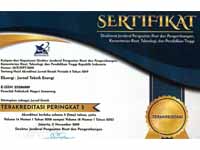Analysis of the Utilization of Organic Waste into Biogas Alternative
DOI:
https://doi.org/10.32497/eksergi.v19i01.4043Keywords:
organic waste, alternative energy, biogas, energyAbstract
Abstract”” Waste is the main problem experienced by somepeople in Indonesia. The population is getting higher in the spanof a year. Unable with the presence of waste consisting of varioustypes of waste, this problem can be felt, namely negative impactson the surrounding environment, for example the slumenvironment, becoming a source of disease nests, and being atrigger for global warming caused by waste. This study has theaim of analyzing the use of the type of organic waste used foralternative energy, namely Biogas. In this study, we used aliterature review approach. An approach similar to the one usedhere is used to collect various data from previously conductedresearch on topics related to those being discussed here. Animalwaste, fruit and vegetable waste, and other forms of organicwaste can be converted into biogas faster than inorganic waste.For the production of biogas, mixing vegetables together isbetter than cutting them. Biogas that has been processed can beused as alternative energy that can benefit various sectors. Theuse of organic waste into biogas can reduce the problem of wastein Indonesia.
References
REFERENCES
Alfi Hasanah, A. “Analisis Berbagai Sampah Organik Sebagai Energi Alternatif Biogas Terbarukan”. Jurnal Teknologi Lingkungan Lahan Basah, 10(2), 174-183.
Damayanti, A. A., Fuadina, Z. N., Azizah, N. N., Karinta, Y., & Mahardika, I. K. (2021). “Pemanfaatan Sampah Organik Dalam Pembuatan Biogas Sebagai Sumber Energi Kebutuhan Hidup Sehari-hari”. Eksergi, 17(3), 182-190.
Hasanudin, U., Nurdin, S. U., Indraningtyas, L., & Fadhallah, E. G. (2021). “Pelatihan Pemanfaatan Sampah Organik menjadi Biogas dan Pupuk Cair”.
Hendrasarie, N., & Edison, R. P. (2021). “Pelatihan Pembuatan Biogas Dari Limbah Rumah Makan dan Tinja”. ABDIMAS UNWAHAS, 6(2).
Indriyani, N., Heremba, S., Agustian, I., Salim, M., Ma”™arif, S., Resky, I., & Panjaitan, T. (2022). “Pemanfaatan Kotoran Ternak Sebagai Biogas Dan Pupuk Organik Di Desa Klasmelek”. Jurnal Abdimasa Pengabdian Masyarakat, 5(1), 69-74.
Kamandang, Z. R., Solin, D. P., & Casita, C. B. (2021). “Pemanfaatan Teknologi Biogas untuk Pengelolaan Sampah Organik”. Jurnal Abdimas Teknik Kimia, 2(01), 45-49.
Pranata, I. W. D. E., Dantes, K. R., & Wiratmaja, I. G. (2020). “Rancang Bangun Reaktor Pengolah Limbah Organik Menjadi Biogas Sebagai Bahan Bakar Alternatif Kendaraan Bermotor”. Jurnal Pendidikan Teknik Mesin Undiksha, 8(1), 35-42.
Rhohman, F. (2021). “Analisa Matematis Hasil Biogas Dari Sampah Sayuran Berdasarkan Perbedaan Jumlah Bahan”. Jurnal Mesin Nusantara, 4(2), 84-89.
Saptaji, K., Fikri, M. R., Hadisujoto, I. B. S., & Harjon, A. (2021). “Sosialisasi Pemanfaatan Sampah Organik Rumah Tangga Untuk Biogas Dan Pemasangan Biodigester”. Jurnal Pengabdian Masyarakat Teknik, 4(1), 11-18.
Sastrawan, S., Ridhana, F., Erita, E., & Pitriyanto, N. (2021). T”eknik Pengolahan Limbah Kotoran Sapi Bali Untuk Pembuatan Biogas Di Kampung Paya Tungel Kecamatan Jagong Jeget”. JIPVET: Jurnal Ilmu Peternakan dan Veteriner, 3(2), 30-40.
Downloads
Published
Issue
Section
License
Authors who publish with this journal agree to the following terms:Authors retain copyright and grant the journal right of first publication with the work simultaneously licensed under a Creative Commons Attribution License that allows others to share the work with an acknowledgement of the work's authorship and initial publication in this journal.
Authors are able to enter into separate, additional contractual arrangements for the non-exclusive distribution of the journal's published version of the work (e.g., post it to an institutional repository or publish it in a book), with an acknowledgement of its initial publication in this journal.
Authors are permitted and encouraged to post their work online (e.g., in institutional repositories or on their website) prior to and during the submission process, as it can lead to productive exchanges, as well as earlier and greater citation of published work (See The Effect of Open Access).






